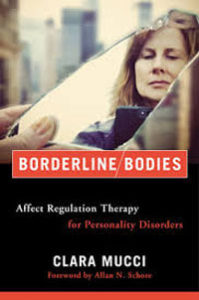by Clara Mucci (Italy)
 A bold look at the body as a source of contention for those who suffer from personality disorders, this W.W. Norton book (2018), featuring a foreword by Allan Schore, connects interpersonal neurobiology, attachment theory, and psychoanalytic theory with cognitive and neuroscientific work on implicit memory, trauma theory, and dissociation to propose an integrated method for treating severe borderline and narcissistic disorders, with the prime aim of resolving the affect dysregulation that affects the various realms of bodily discomfort and existential pain.
A bold look at the body as a source of contention for those who suffer from personality disorders, this W.W. Norton book (2018), featuring a foreword by Allan Schore, connects interpersonal neurobiology, attachment theory, and psychoanalytic theory with cognitive and neuroscientific work on implicit memory, trauma theory, and dissociation to propose an integrated method for treating severe borderline and narcissistic disorders, with the prime aim of resolving the affect dysregulation that affects the various realms of bodily discomfort and existential pain.
Each chapter presents a particular case and illustrates the methods for working with the specific problems that arise, from bulimia to self-cutting to sexual identity diffusion to suicidality. Treatment is illustrated from the initial level of careful diagnosis to the first stages of the interaction to the further steps and development of the interpersonal work of the patient-therapist dyad, including powerful enactments.
In accessible language that references psychodynamic and relational psychoanalytic theory, the book proposes a revision of the etiology of personality disorders, starting from the traumatic interpersonal exchanges (early relational trauma, maltreatment, deprivation, and abuse).
The body is accorded full attention in the treatment: developmentally and epigenetically situated as it is “in-between” the self and the other (at first, the caregiver; then, in other circumstances of upbringing and traumatic personal relationships). The body is viewed as the main vehicle of this dysfunctional development, so that both body and subject are at once the “victim”—the recipient of the dysregulation resulting in impulsivity, destructiveness, self-harm, or eating disorders—and the internalized persecutor, i.e. the abuser of one’s own body that sometimes also becomes the aggressor of others.
Humane and scientifically sound, this book is intended for professionals, clients, and families involved in the difficult task of relieving the symptoms and reorganizing the personalities of subjects living in “borderline bodies.”
Table of Contents:
- Personality Disorders and the Traumatized Body between Self and Other
- The Body between Nature and Culture
- How to Treat the Borderline Patient
- When There is No Mirror for the Child: The Dead Mother Complex
- Sexuality, Gender, and Identity Diffusion in Severe Personality Disorders
- Complex PTSD and Dissociation
- Narcissistic Personality Disorders
- Suicidal Tendencies and Risk of Suicide in Borderline and Narcissistic Patients
- Psychosomatic Disorders and the Far End of the Narcissistic Spectrum
- Hypochondria, Antisocial Traits, and Perversion
Link: http://books.wwnorton.com/books/Borderline-Bodies/
 Clara Mucci, PhD, is a clinical psychologist, case supervisor, and professor of psychology at Universita Gabriele D’Annunzio. She lives in Italy.
Clara Mucci, PhD, is a clinical psychologist, case supervisor, and professor of psychology at Universita Gabriele D’Annunzio. She lives in Italy.
Email Clara Mucci

